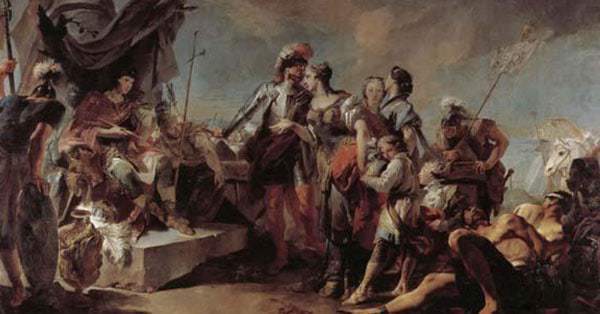Aurelian was the Emperor of Rome from 270 and 275 and is arguably one of the most underrated rulers of the Empire; at least amongst casual history lovers. By the time he came to power, the Empire was on the brink of collapse. Its economy was in ruins, it was still recovering from the Plague of Cyprian and the quick turnover of emperors throughout the Third Century Crisis meant there was no one strong enough to form a stable government.

To make matters worse, the Romans were under attack from all sides as barbarian enemies’ sensed weakness and moved in for the kill. Had Rome been led by yet another weak emperor at this time, it may well have lost its empire forever. Instead, Aurelian seized the throne, quelled the outside threats and initiated reforms he never got to complete. In this article, I look at 5 interesting facts about one of Rome’s greatest rulers.
1 – He Destroyed All of Rome’s Immediate Threats within a Few Years
Above all else, Aurelian was an outstanding general and is best known for his numerous successes against a variety of tribes bent on Rome’s destruction. Aurelian quickly rose through the ranks of the army and became known for his exploits as a soldier on the Danube frontier. In 268 AD, when Aureolas rebelled against Emperor Gallienus, Aurelian was in command of cavalry in northern Italy. He was involved in the Siege of Mediolanum and is said to have raised the alarm at night; an act that caused Gallienus to leave his tent. The emperor was assassinated.
He was a main contender for the throne, but it was awarded to Claudius II Gothicus. The new emperor appointed Aurelian as Master of the Horse which effectively made him the second most powerful man in the empire as he had command of the military. Claudius died suddenly in 270 and his brother, Quintillus, became the new emperor. Aurelian believed the title was his and claimed it at Sirmium in August 270. Quintillus fled and, realizing he had no support; he committed suicide in Aquileia.
Aurelian was the undisputed ruler of the Empire, but he had no time to rest on his laurels as there were multiple threats to deal with. His first order of business was to deal with the Juthungi who had invaded Northern Italy. The Roman army caught up with the enemy and defeated them before they could flee back beyond the Danube. Aurelian marched to Rome and was officially declared Emperor by the Senate.
Almost immediately, he had to return north to fight the Vandals and Sarmatians who had crossed the Danube. Aurelian’s army arrived and crushed the enemy; he even asked his men if the Vandals should be allowed to return home before granting them safe passage. He also took 2,000 cavalry from them. Even before the Vandals had withdrawn, a combination of the Juthungi, Marcomanni, and Alemanni descended on Northern Italy from the Alps. Aurelian then suffered a rare defeat at Placentia in 271. Back in Rome, riots began once the news filtered through although the violence may have started due to a combination of other factors.
The barbarians made the mistake of dividing their large army into numerous smaller forces so they could move faster and plunder more. Aurelian seized the opportunity by finding every one of the smaller armies and defeating them. There was no time to waste because he had to return to Rome to handle the riots. His men suppressed the riots, and thousands of people died including several senators who were executed on the orders of the emperor. Knowing that the riots were partly due to fear of invasion, the Emperor ordered the construction of the Aurelian Walls to keep barbarians at bay long enough for an army to return to save the day if necessary.
While there were a couple of pretenders to the throne, the real threat was the Gallic Empire in the West and the Palmyrene Empire in the East which had split from the Roman Empire. He knew that Palmyra, ruled by Queen Zenobia, was a greater threat, so he attacked it first. It controlled Egypt and Rome’s grain supply, so it was essential to destroy the independent state. Aurelian marched east but defeated the Goths in several large battles en route in 272. Meanwhile, the emperor also decided to withdraw from Dacia and ordered the evacuation of Romans from the region.
Aurelian continued east and had few problems in Asia Minor as only the city of Tyana resisted. He captured it easily but forbade his men from sacking it. This was an excellent decision because it led to several cities in Greek and the whole of Egypt returning to the Empire without any kind of a fight. Later in 272, Aurelian defeated the Palmyrene army at Immae and Emesa. The enemy surrendered, and the Romans captured Queen Zenobia. As soon as he left, the Palmyrenes staged an uprising. He returned immediately and brutally suppressed it, allowing his men to rape, pillage and plunder.
Only the Gallic Empire stood between Aurelian and the completion of his mission. In 274 AD, he defeated the Gallic leader Tetricus at Chalons-sur-Marne and restored the Empire. He paraded the beaten enemy leaders in his triumph in Rome but spared both their lives. In the space of a few years, Aurelian had foiled multiple invasion attempts, re-established the Empire, oversaw a return to Roman control on the frontiers and ensured he was the undisputed leader after decades of uncertainty. He truly earned the name restitutor orbis, Restorer of the World.

